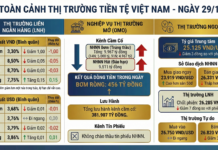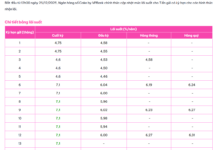What is a 1-month fixed-term savings account?
A 1-month fixed-term savings account is a popular short-term savings option offered by banks today. Customers deposit their “idle” funds with the bank for 1 month and the bank pays interest on this amount for the 1-month term. After 1 month, customers can either close the account and withdraw their funds or continue with the account.
The 1-month term can be considered the shortest term in all banks’ fixed-term savings interest rate schedules. The interest rate for a 1-month fixed-term savings account is often higher compared to non-fixed and demand deposits. This is also a popular short-term savings option for salaried individuals.
What is a 3-month fixed-term savings account?
A 3-month fixed-term savings account is a type of savings account where depositors can only withdraw their funds after the 3-month term as agreed upon with the deposit-taking organization.
This means that you deposit your savings with the bank for 3 months and at the end of the 3-month term, you can either fully withdraw your principal plus interest or renew the term or choose another term (1 month, 6 months, 12 months) to continue saving.

Illustrative Photo
Should I choose a 1-month or a 3-month fixed-term savings account?
For individuals with short-term idle funds
For those who have regular needs for early withdrawal or those who are unable to save for long periods, it is advisable to choose shorter terms to have more flexibility in using their funds.
In fact, most banks currently offer deposit terms of only 1 week, 2 weeks, 3 weeks, 1 month, and 2 months. Each term comes with different interest rates, typically ranging from 1% per annum to 5% per annum to facilitate customers’ choices.
The advantage of this type of deposit is the flexibility in fund availability while still gaining a better interest rate compared to non-fixed-term deposits.
For individuals with stable long-term idle funds
For customers with a large, stable idle fund or no specific use for the money in the foreseeable future, or for those who can handle unforeseen problems without accessing their savings, it is advisable to choose a 3-month fixed-term savings account or longer terms.
This is an effective, stable, and safe investment form. When participants engage in long-term deposits, they have a wide range of terms to choose from, such as 3 months, 6 months, 9 months, 12 months, 24 months, 36 months, or even 13 months, 14 months, 20 months, and so on.
One notable advantage of long-term deposits is the attractive interest rate, which is much higher than that of short-term deposits, ranging from 5.1% per annum to 8% per annum. Moreover, if emergency withdrawals are necessary, the depositor still earns an interest rate similar to a non-fixed-term savings account.




































